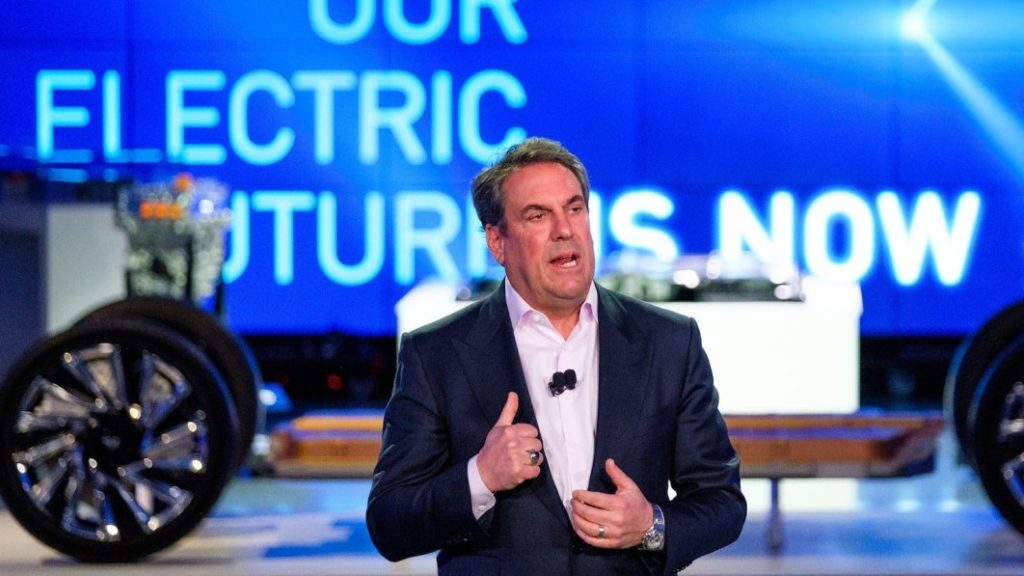5 things OEMs and shoppers are get wrong about EVs – GM president

In an interview, Mark Reuss, the president of
General Motors, pushed back on misconceptions about
electric vehicles.
Bill Pugliano/Getty Images
General Motors’ president spoke with Insider about EVs as GM pivots away from internal combustion.
Mark Reuss says internal-combustion-engine and electric-vehicle teams can coexist.
He suggested that new battery tech could solve grid-overload worries.
As electric vehicles enter the market, misconceptions abound regarding the cars and how automakers can remain profitable while ditching the internal combustion engine, says Mark Reuss, General Motors’ president.
GM is looking to position itself as a leader in electric vehicles, putting billions of dollars toward electrifying its fleet and promising a future without fossil-fuel emissions. But Reuss said that being a legacy car company competing with the likes of Tesla, Rivian, and Lucid can create confusion among both consumers and industry experts.
Reuss recently sat down with Insider to set the record straight on a few aspects of the EV market as he sees it today.
Companies need hybrids to bridge the gap to full EVs
Some automakers have been making the transition to electric lineups with a pit stop: hybrids. Toyota, for example, has invested in hybrids in addition to electric products and has faced skepticism from the industry as a result.
“We’re not going to dilute our investment with hybrids,” Reuss said, adding that the automaker expects its EV business to be profitable by 2025. GM stopped producing its last hybrid, the Chevrolet Volt, in 2019.
“If you look at some of the other companies that are doing or have signaled that they’re going to have an all-electric lineup, the profitability picture is quite different,” Reuss said.
EV and internal-combustion-engine teams need to be separated
Next to Reuss’ computer in his office at GM’s Tech Center is a blue bumper sticker that says “coexist.”
It’s not the typical Coexist bumper sticker that features various religious and cultural symbols — this one has internal-combustion-engine parts and battery parts, signaling GM’s approach to integrating its powertrain engineers.
“That’s the attitude,” Reuss said. “People go back and forth.”
GM’s crosstown rival Ford, meanwhile, recently decided to split its gas-powered and EV businesses into separate operational divisions in a bid to allow the EV business to operate independently while the gas-powered side of the business continues to feed Ford’s bottom line.
EVs will overload the electrical grid
Many people worry that aging electrical infrastructure can’t handle an influx of charging car batteries.
Reuss says GM and others in the industry are already working to solve this problem with energy storage and vehicle-to-grid energy-sharing technology. For GM, that’s being handled by a new department dubbed GM Energy, which Reuss said would offer a product designed to send unused energy back to the electrical grid at peak hours.
“People say, ‘Oh, there’s no way the grid can support EVs,'” Reuss said. “No, that’s not true.”
The charging experience and the driving experience are one and the same
Reuss said it can be frustrating to see drivers rate vehicles based on the charging experience alone.
While he acknowledged that the plug-in infrastructure has a long way to go, he said GM has built its EVs to drive as far as a gas-powered vehicle between charges.
He added that GM, through partnerships with charging companies and other fueling stations, was also working on ways to improve charging so drivers can focus on the work engineers have put into the driving experience for vehicles like the Cadillac Lyriq and the GMC Hummer EV.
“It’s all coming,” Reuss said. “Is it perfect yet? No.”
Charging-industry consolidation is bad for EV drivers
Even as the EV-charging industry heats up, startups that flooded it over the past several years are facing harder times. A spate of mergers and acquisitions is likely to lower the number of companies, but Reuss said that’s not necessarily a bad thing.
“I don’t think that’s unhealthy,” Reuss said of the activity. “Not everybody should be able to make money at it just like that.
“That’s why I think partnerships can be very, very good,” he added. “The people who realize that and put the money in the right places for people will benefit.”



